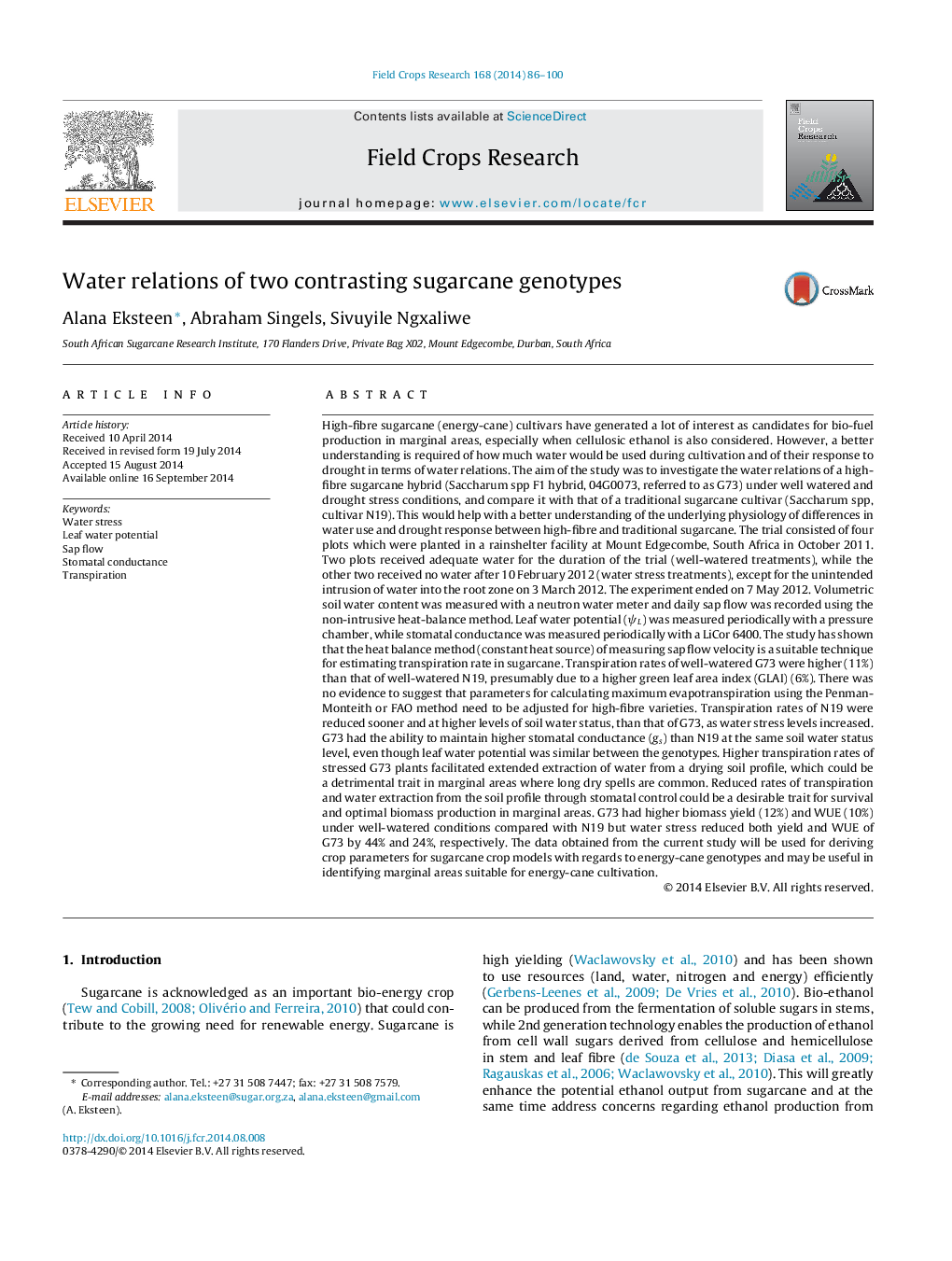| کد مقاله | کد نشریه | سال انتشار | مقاله انگلیسی | نسخه تمام متن |
|---|---|---|---|---|
| 4509973 | 1624695 | 2014 | 15 صفحه PDF | دانلود رایگان |
• Sugarcane transpiration can be estimated reliably with heat balance sap flow technology.
• High-fibre sugarcane used more water than traditional cane because it had a higher leaf area index.
• Transpiration rates declined sooner in traditional cane than in high-fibre cane, in response to water stress.
High-fibre sugarcane (energy-cane) cultivars have generated a lot of interest as candidates for bio-fuel production in marginal areas, especially when cellulosic ethanol is also considered. However, a better understanding is required of how much water would be used during cultivation and of their response to drought in terms of water relations. The aim of the study was to investigate the water relations of a high-fibre sugarcane hybrid (Saccharum spp F1 hybrid, 04G0073, referred to as G73) under well watered and drought stress conditions, and compare it with that of a traditional sugarcane cultivar (Saccharum spp, cultivar N19). This would help with a better understanding of the underlying physiology of differences in water use and drought response between high-fibre and traditional sugarcane. The trial consisted of four plots which were planted in a rainshelter facility at Mount Edgecombe, South Africa in October 2011. Two plots received adequate water for the duration of the trial (well-watered treatments), while the other two received no water after 10 February 2012 (water stress treatments), except for the unintended intrusion of water into the root zone on 3 March 2012. The experiment ended on 7 May 2012. Volumetric soil water content was measured with a neutron water meter and daily sap flow was recorded using the non-intrusive heat-balance method. Leaf water potential (ψL) was measured periodically with a pressure chamber, while stomatal conductance was measured periodically with a LiCor 6400. The study has shown that the heat balance method (constant heat source) of measuring sap flow velocity is a suitable technique for estimating transpiration rate in sugarcane. Transpiration rates of well-watered G73 were higher (11%) than that of well-watered N19, presumably due to a higher green leaf area index (GLAI) (6%). There was no evidence to suggest that parameters for calculating maximum evapotranspiration using the Penman-Monteith or FAO method need to be adjusted for high-fibre varieties. Transpiration rates of N19 were reduced sooner and at higher levels of soil water status, than that of G73, as water stress levels increased. G73 had the ability to maintain higher stomatal conductance (gs) than N19 at the same soil water status level, even though leaf water potential was similar between the genotypes. Higher transpiration rates of stressed G73 plants facilitated extended extraction of water from a drying soil profile, which could be a detrimental trait in marginal areas where long dry spells are common. Reduced rates of transpiration and water extraction from the soil profile through stomatal control could be a desirable trait for survival and optimal biomass production in marginal areas. G73 had higher biomass yield (12%) and WUE (10%) under well-watered conditions compared with N19 but water stress reduced both yield and WUE of G73 by 44% and 24%, respectively. The data obtained from the current study will be used for deriving crop parameters for sugarcane crop models with regards to energy-cane genotypes and may be useful in identifying marginal areas suitable for energy-cane cultivation.
Journal: Field Crops Research - Volume 168, November 2014, Pages 86–100
